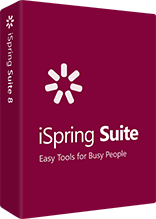Choosing the best color scheme for the presentation
This is a modest collection of treasured tips on how to combine colors properly and create a compelling palette for your presentation.
Let’s imagine. You are to create an awesome presentation. What’s your first thought? It’s probably something like “I should find a superb content!” And you’re right. But there is something just as important as the content – the color. To choose the right one you don’t need to be an ink matcher, just read this article!
Not to speak at random, we rely on iSpring table-top book – Slide:ology by Nancy Duarte.
“The color sets a tone and helps establish what the audience will expect. It helps communicate what type of journey you will be taking the viewers on” – Nancy Duarte considers. Pick the colors that clearly represent these three things:
- The audience. Once you have a clear image of your audience you can determine the color that will appeal to it or won’t resonate with it.
- The industry. There’s a range of clichés associated with different areas and industries. To stand out in your field review color schemes used by your competitors and choose something different. Also, avoid colors that are negative in your industry. For example, red should be avoided for a financial institution but would be okay for a blood bank.
- Your company. No matter if your brand is modern or conservative, the color should represent the essence of your company.
Curiously enough Isaac Newton’s discovery can help you with your presentation. Don’t be surprised! Sir Isaac Newton color wheel is an irreplaceable piece of knowledge for a presentation’s creator. The wheel uses three primary colors, red, yellow and blue, spaced evenly apart. Blending those colors creates the full color wheel.

Now it’s time for high spot. Here are some general ways of color combination. Enjoy!

Monochromatic
Use different variations of the same color. Adding a bit of white, black or grey will create a nice contrast. However don’t forget that when shown on the projector, similar colors can be really hard to recognize.

Analogous
To create a harmonious color scheme select colors that lie next to each other in the wheel. Depending on where exactly they lie they can provide either warm or cool feeling.

Complementary
Choose colors from the opposite sides of the wheel since they are the most contrasting and can create a really powerful look.

Split Complementary
It is a variation of the complementary scheme. The difference is that you choose not the opposite color but two colors that lie on either side of it.

Triadic
To form a vivid look pick three colors equally spaced around the color wheel. Pick either tints or shades of those colors to create unusual variations.

Tetradic
Two pairs of complementary colors can be used at once. This scheme works better if you select one dominant color and use the tints of others to support the main one.
Looking for more multicolored inspiration? Another way to be inspired is to watch cool presentations created by professionals. Inspiration is waiting for you in iSpring colorful demos.
Now when you’re inspired and aware of all these tricks, you can use them in practice. Download iSpring Suite FREE trial and try out all of them with this powerful award-winning authoring tool!
We are looking forward to hearing from you!
This article is based on the book “Slide:ology” by Nancy Duarte.



